A POIs Based Method for Location Optimization of Urban Fire Station: A Case Study in Zhengzhou City
Abstract
:1. Introduction
2. Introduction of Layout Optimization Models
2.1. P-Median Model
2.2. SCLP Model
2.3. MCLP Model
2.4. Location-Allocation (LA) Model
3. Calculation Principle and Evaluation Indexes
3.1. Impedance Interruption
- The POI point outside of the impedance interruption of all fire stations will not be allocated;
- If a POI point is within the impedance interruption of a fire station, the POI will be assigned to the fire station;
- If a POI point is located within the impedance interruption of two or more fire stations, the point is only assigned to the nearest fire station.
3.2. Calculation Principle
3.3. Constraint Condition
3.4. Evaluation Indexes of Optimization Effect
- (1) Coverage rate of fire demand points
- (2) Full coverage and overlapping coverage of service areas of fire stations
- (3) Accessibility of fire station within the target area
4. Practical Example
4.1. Current Fire Stations in Zhongyuan District
4.2. POIs Distribution of Zhongyuan District
4.3. Optimization Scheme
4.4. Coverage Analysis of Different Number of Fire Stations
4.5. Determination of the Number and Location of Fire Stations
5. Service Area Identification of Fire Stations
5.1. Principle of Topological Convex Hull
5.2. Division of Service Areas
- (1) Analysis of service areas of seven existing fire stations
- (2) Analysis of service areas of fire stations after optimization
5.3. POIs Coverage Rate after Optimization
5.4. Time Sensitivity Analysis of Reachable Area
6. Conclusions
- (1) Based on the spatial distribution of POIs, an optimization method for spatial layout in the urban fire station is proposed. The LA model includes the MFM and MCM algorithms. Two principles should be combined in optimizing the layout of fire stations. Firstly, as a public facility serving the city, the fire stations should consider as many fire demand points (fire risk points) as possible. The fire stations should maximize the coverage rate of fire demand points. Secondly, the scope and shape of the service area of the fire stations should be reasonably identified. The identified method should make the optimized station maximize the coverage area and minimize the repeated coverage area of the target region. Based on such an understanding, the service area is identified by using the topological partition method of the convex hull according to the POIs assigned to the stations;
- (2) The LA model is further used to optimize the spatial layout of fire stations in the Zhongyuan District of Zhengzhou City. Taking response time as the constraint, the coverage of seven existing fire stations is analyzed. The results show that the coverage rates of the area and POIs are 31.34% and 71.94%, respectively. The optimization results show that 10 fire stations are needed in the target district, which provides coverage for 95% of the POIs. Regarding the hotel, the highest coverage rate in POIs is reached, which is 98.1%. The fire risk place is the lowest, which also reaches 89.3%. The coverage rate of other categories of POI points is consistently over 90%. Only a small area is uncovered within 4.3 min. After the planning work, the firefighting capacity of fire stations has been greatly strengthened;
- (3) The sensitivity of the accessible region of the fire stations to the travel time is analyzed. It was found that the evolution curve of the coverage rate in response to the travel time showed an increasing trend, but the rising speed slowed down at long travel time. The optimized curve grows more quickly than the current curve, which means the coverage area of the optimized 10 fire stations has been greatly improved compared with that of the existing fire stations. Especially within 10 min of the travel time, the growth in the coverage area is more obvious after optimization. The area reached within 4.3 min increases from 61.1 to 108.8 km2, accounting for 50% of the target district. About 94% of the research area can be reached in 10 min, and all areas can be reached in 15 min. Overall accessibility is desirable;
Author Contributions
Funding
Data Availability Statement
Conflicts of Interest
References
- China Fire Yearbook; Yunnan People’s Publishing House: Kunming, China, 2018.
- Challands, N. The Relationships Between Fire Service Response Time and Fire Outcomes. Fire Technol. 2010, 46, 665–676. [Google Scholar] [CrossRef]
- Analysis of the Fire Accident in Harbin “8.25” Beilong Tangquan Leisure Hotel. 2019. Available online: http://yjgl.hlj.gov.cn/#/NewListDetail?id=49538&parentName (accessed on 24 July 2020).
- Investigation Report on “2·16” Fire Accident in Qingcheng District, Qingyuan City. 2019. Available online: http://www.huiyang.gov.cn/hyqzdlyxxgk/aqsc/sgdcbg/content/post_2465632.html (accessed on 29 April 2021).
- Investigation Report on “5.25” Fire Accident in Pingdingshan, Henan Province. 2015. Available online: https://www.mem.gov.cn/gk/sgcc/tbzdsgdcbg/2015/201510/t20151014_245219.shtml (accessed on 28 May 2021).
- Shahparvari, S.; Fadaki, M.; Chhetri, P. Spatial accessibility of fire stations for enhancing operational response in Melbourne. Fire Saf. J. 2020, 117, 103149. [Google Scholar]
- Nyimbili, P.H.; Erden, T. GIS-based fuzzy multi-criteria approach for optimal site selection of fire stations in Istanbul, Turkey. Soc.-Econ. Plan. Sci. 2020, 71, 100860. [Google Scholar] [CrossRef]
- Rodriguez, S.A.; Fuente, R.A.; Aguayo, M.M. A facility location and equipment emplacement technique model with expected coverage for the location of fire stations in the Concepción province, Chile. Comput. Ind. Eng. 2020, 147, 106522. [Google Scholar] [CrossRef]
- Liu, D.L.; Xu, Z.S.; Yan, L.; Fan, C.G. Dynamic estimation system for fire station service areas based on travel time data. Fire Saf. J. 2020, 118, 103238. [Google Scholar]
- Liu, D.L.; Xu, Z.S.; Wang, Z.Y.; Zhou, Y.; Fan, C.G. Estimation of effective coverage rate of fire station services based on real-time travel times. Fire Saf. J. 2021, 120, 103021. [Google Scholar] [CrossRef]
- Xu, Z.S.; Liu, D.L.; Yan, L. Evaluating spatial configuration of fire stations based on real-time traffic. Case Stud. Therm. Eng. 2021, 25, 100957. [Google Scholar] [CrossRef]
- Bolouri, S.; Vafaeinejad, A.; Alesheikh, A.; Aghamohammadi, H. The ordered capacitated multi-objective location-allocation problem for fire stations using spatial optimization. Int. J. Geo-Inf. 2018, 7, 44. [Google Scholar]
- Chaudhary, P.; Chhetri, S.K.; Joshi, K.M.; Shrestha, B.M.; Kayastha, P. Application of an Analytic Hierarchy Process (AHP) in the GIS interface for suitable fire site selection: A case study from Kathmandu Metropolitan City, Nepal. Soc.-Econ. Plan. Sci. 2016, 53, 60–71. [Google Scholar] [CrossRef]
- Murray, A.T. Optimising the spatial location of urban fire stations. Fire Saf. J. 2013, 62, 64–71. [Google Scholar]
- Zhang, Q. Fire Risk Assessment and Fire Station Layout Research of CBD in Binhai New Area of Tianjin; Tianjin University: Tianjin, China, 2016. [Google Scholar]
- Li, Y.J. Taiyuan Urban Space Expansion Based on “Smart Growth Theory”; Shanxi Normal University: Xi’an, China, 2013. [Google Scholar]
- Toregas, C.; Swain, R.; ReVelle, C.; Bergman, L. The location of emergency service facilities. Oper. Res. 1971, 19, 1363–1373. [Google Scholar] [CrossRef]
- Kiran, K.C.; Corcoran, J.; Chhetri, P. Spatial optimisation of fire service coverage: A case study of Brisbane, Australia. Geogr. Res. 2018, 56, 270–284. [Google Scholar]
- Zhu, Z.H. Charging Station Location Problem of Electric Vehicles; Beijing Jiaotong University: Beijing, China, 2018. [Google Scholar]
- Chen, Y.L. Geographical Calculation of Optimizing Location of Public Service Facilities in Rural Areas; East China Normal University: Shanghai, China, 2019. [Google Scholar]
- Pu, J.Y. Research on Decision-Making Method of Freeway Traffic Emergency Rescue Resource Deployment; Southeast University: Nanjing, China, 2019. [Google Scholar]
- Yang, X.H. Siting Facilities in Continuous Space to Maximize Spatial Demands Based on GIS; Tsinghua University: Beijing, China, 2013. [Google Scholar]
- Lei, T.L.; Church, R.L.; Lei, Z. A unified approach for location-allocation analysis: Integrating GIS, distributed computing and spatial optimization. Int. J. Geogr. Inf. Sci. 2016, 30, 515–534. [Google Scholar]
- Su, Z.Y. Python Optimization Algorithm; Peking University Press: Beijing, China, 2020. [Google Scholar]
- Fire Department of the Ministry of Public Security. Construction Standard of Urban Fire Station; China Planning Press: Beijing, China, 2017. [Google Scholar]
- Wang, K.; Yuan, Y.F.; Chen, M.M.; Wang, D.Z. A POIs based method for determining spatial distribution of urban fire risk. Process Saf. Environ. Prot. 2021, 154, 447–457. [Google Scholar]
- Que, Z.S.; Hu, H.W.; Chen, S.X. Analysis of the optimization in urban fire station layout planning based on location-allocation of GIS. Beijing Surv. Mapp. 2013, 2, 19–24. [Google Scholar]
- Jin, C.; Lu, Y.L.; Zhang, L.; Xu, Q. An analysis of accessibility of scenic spots based on land traffic network: A case study of Nanjing. Geogr. Res. 2009, 28, 246–258. [Google Scholar]
- Ministry of Housing and Urban-Rural Construction of the People’s Republic of China. Code for Design of Urban Road Engineering (CJJ37-2016); China Architecture & Building Press: Beijing, China, 2016. [Google Scholar]
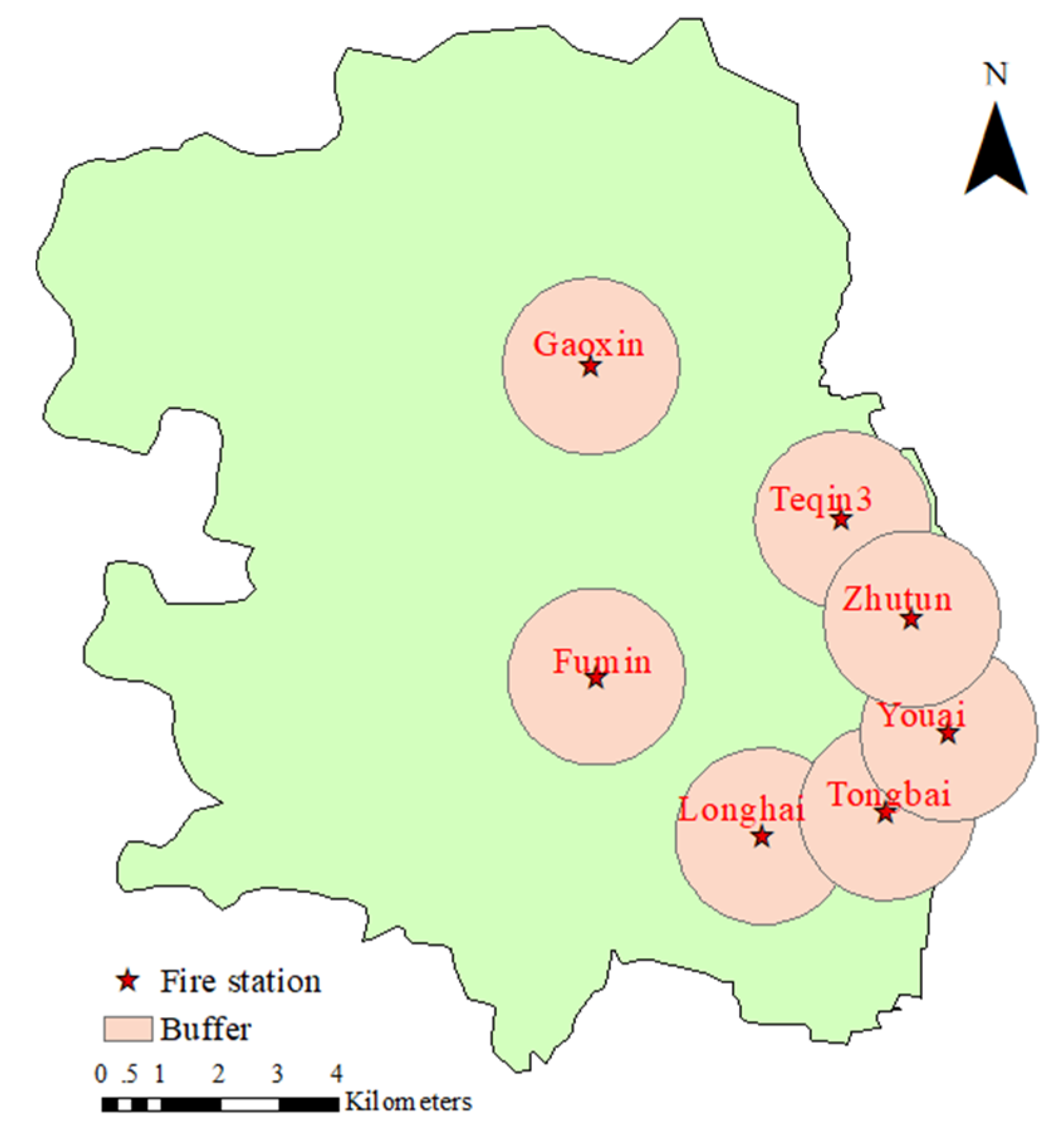
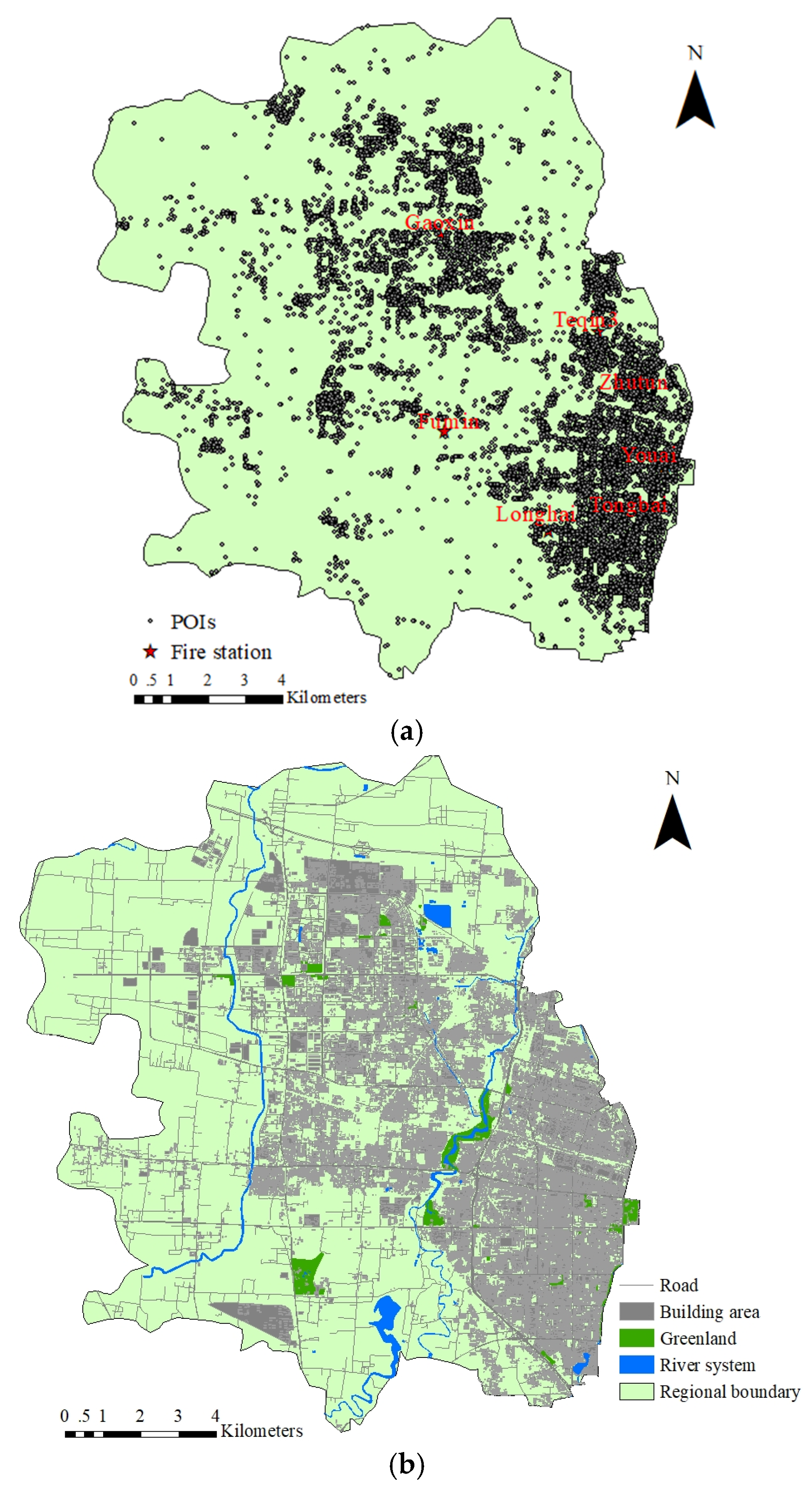


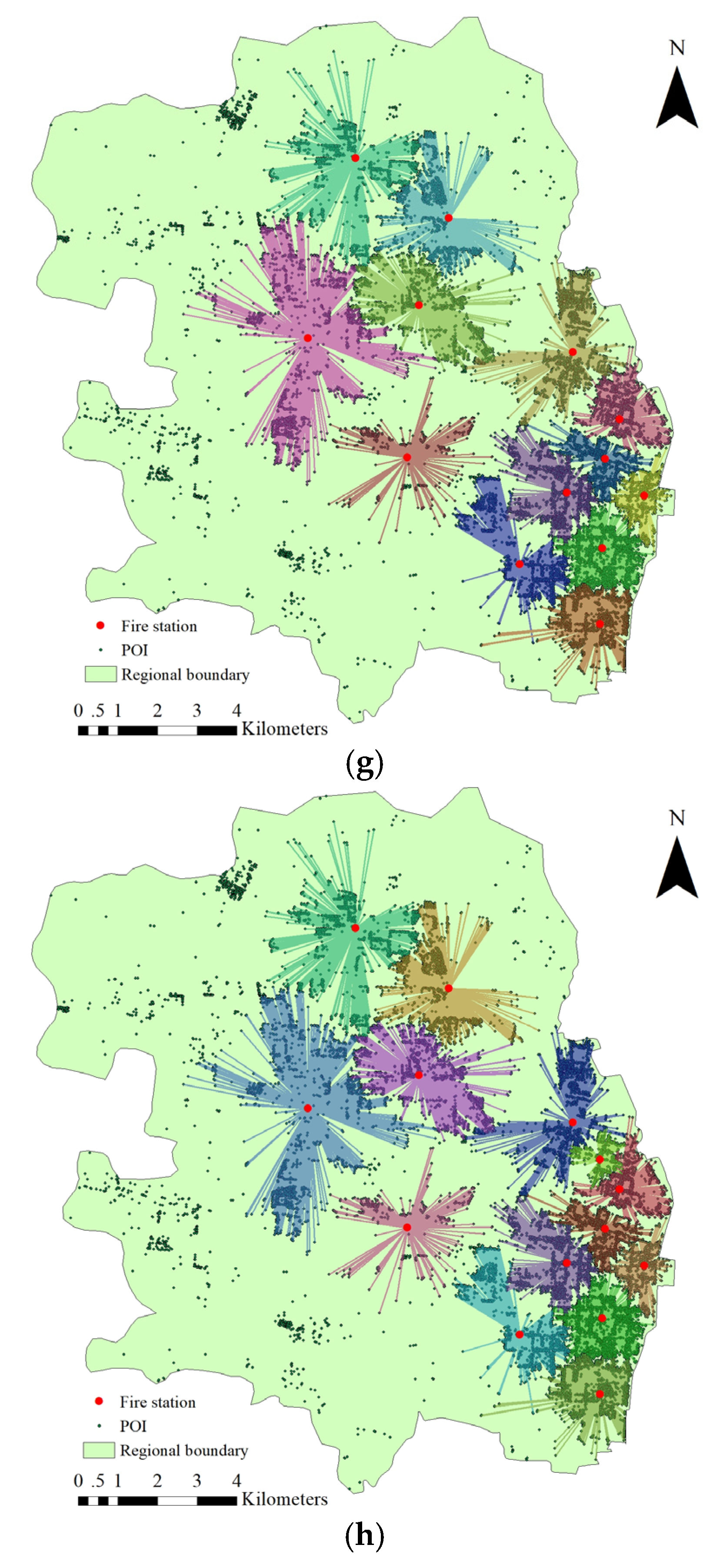
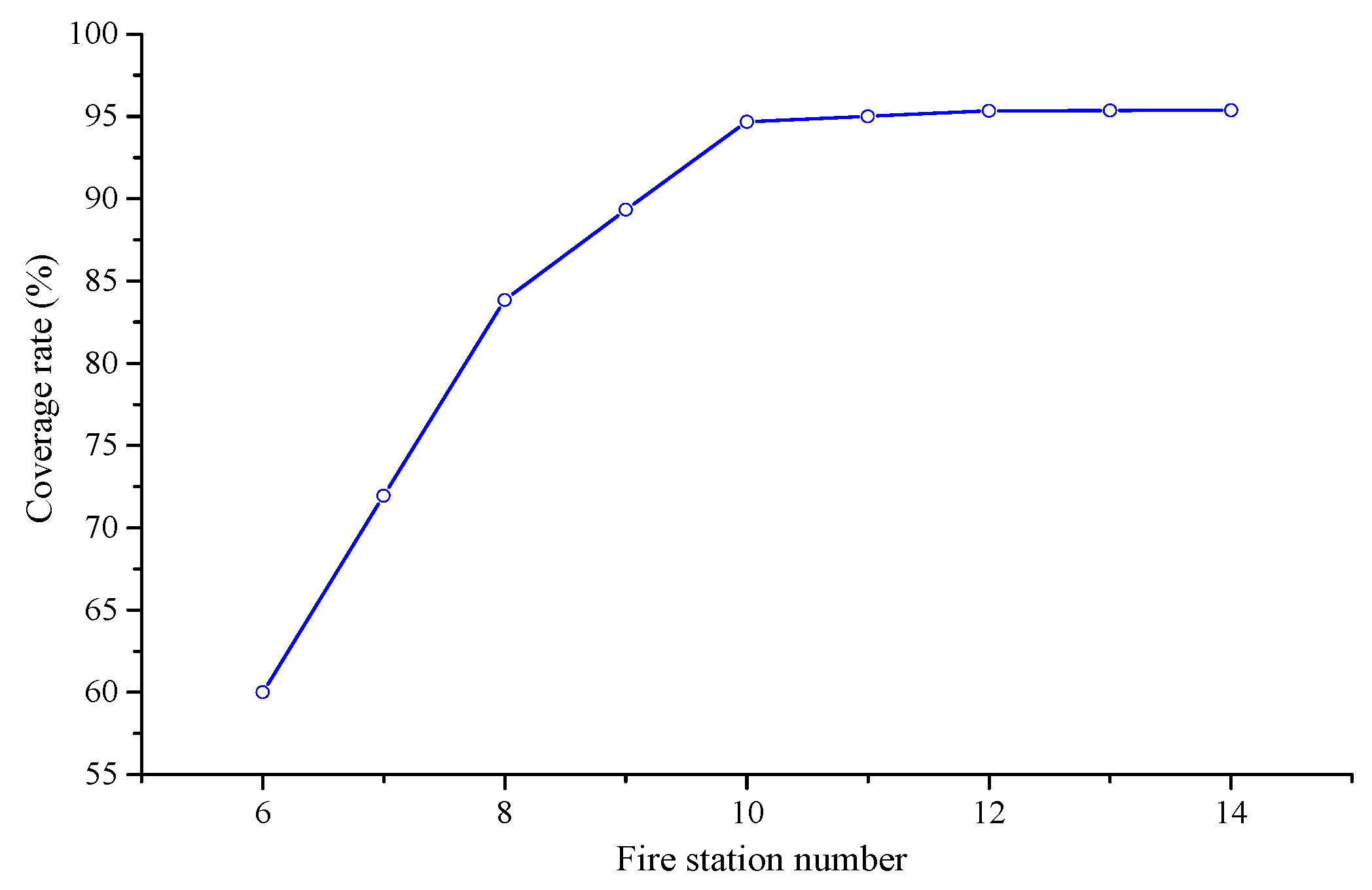
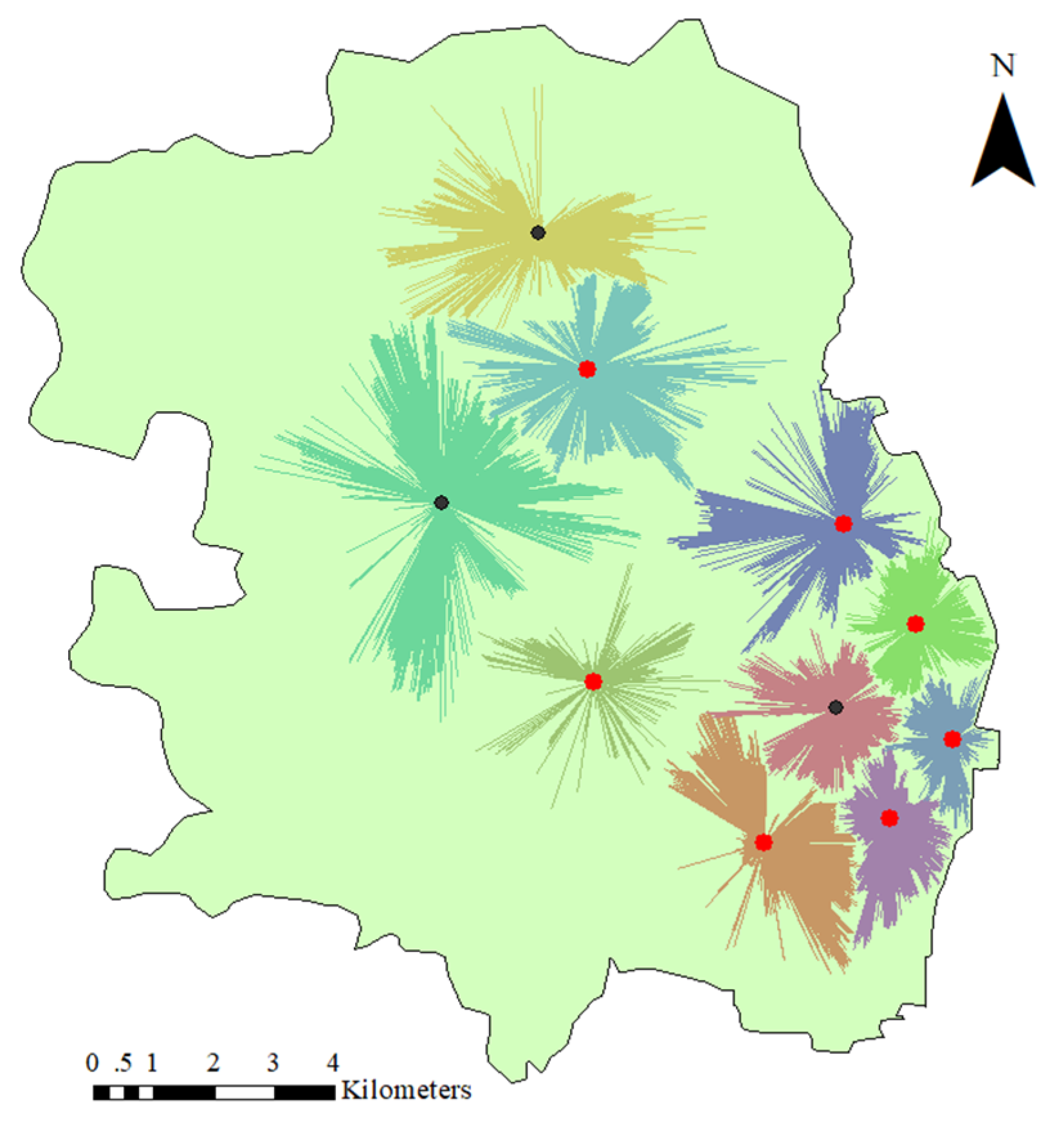
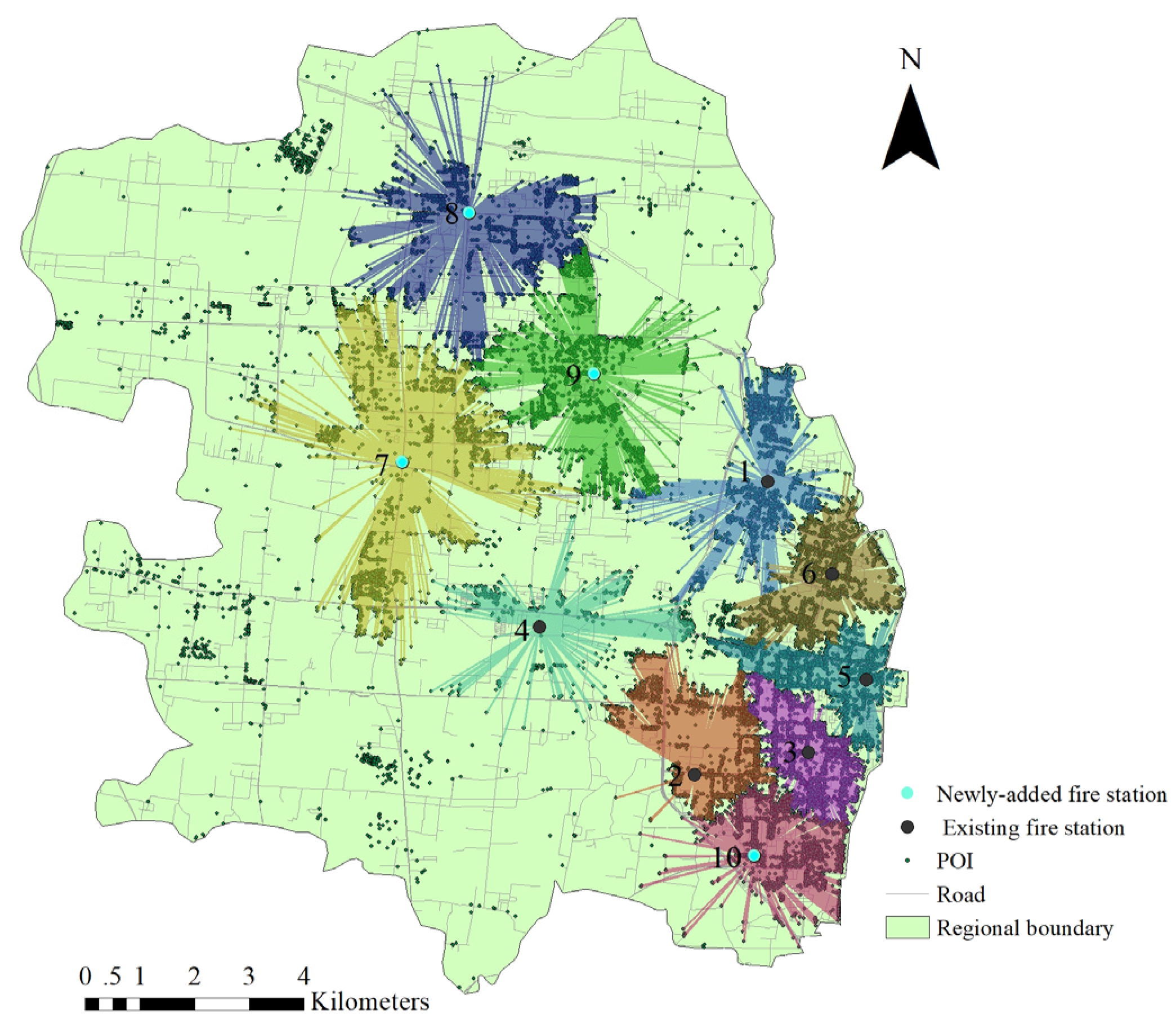
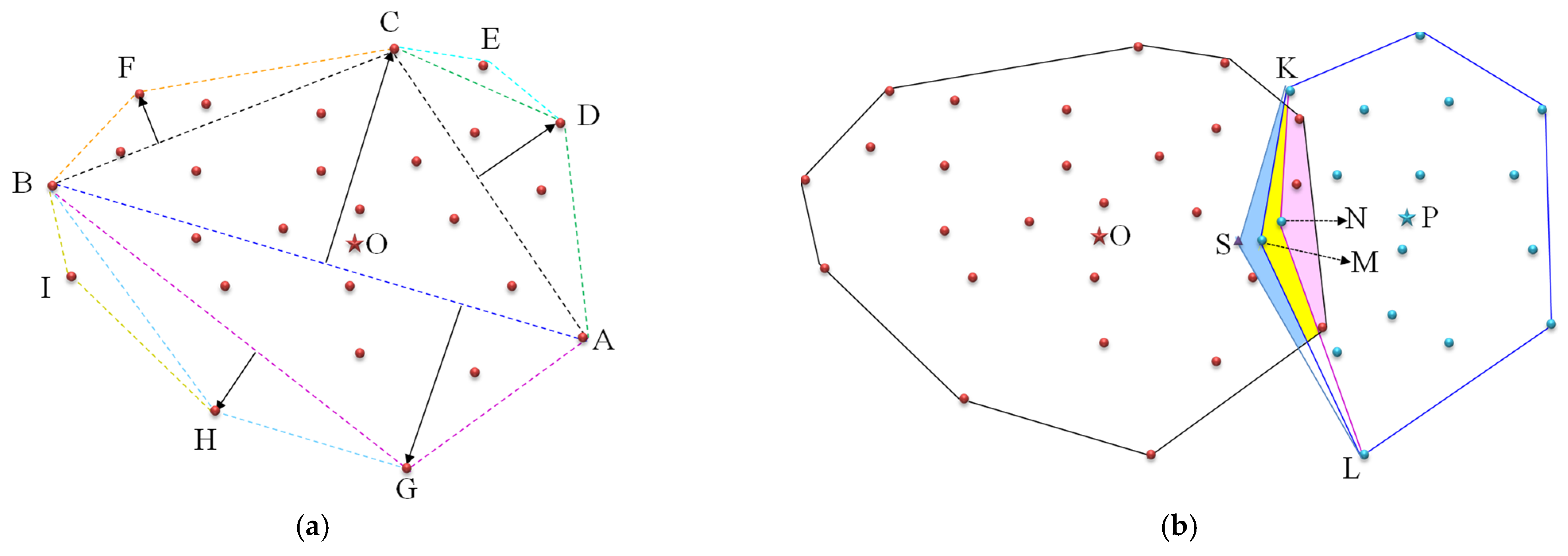
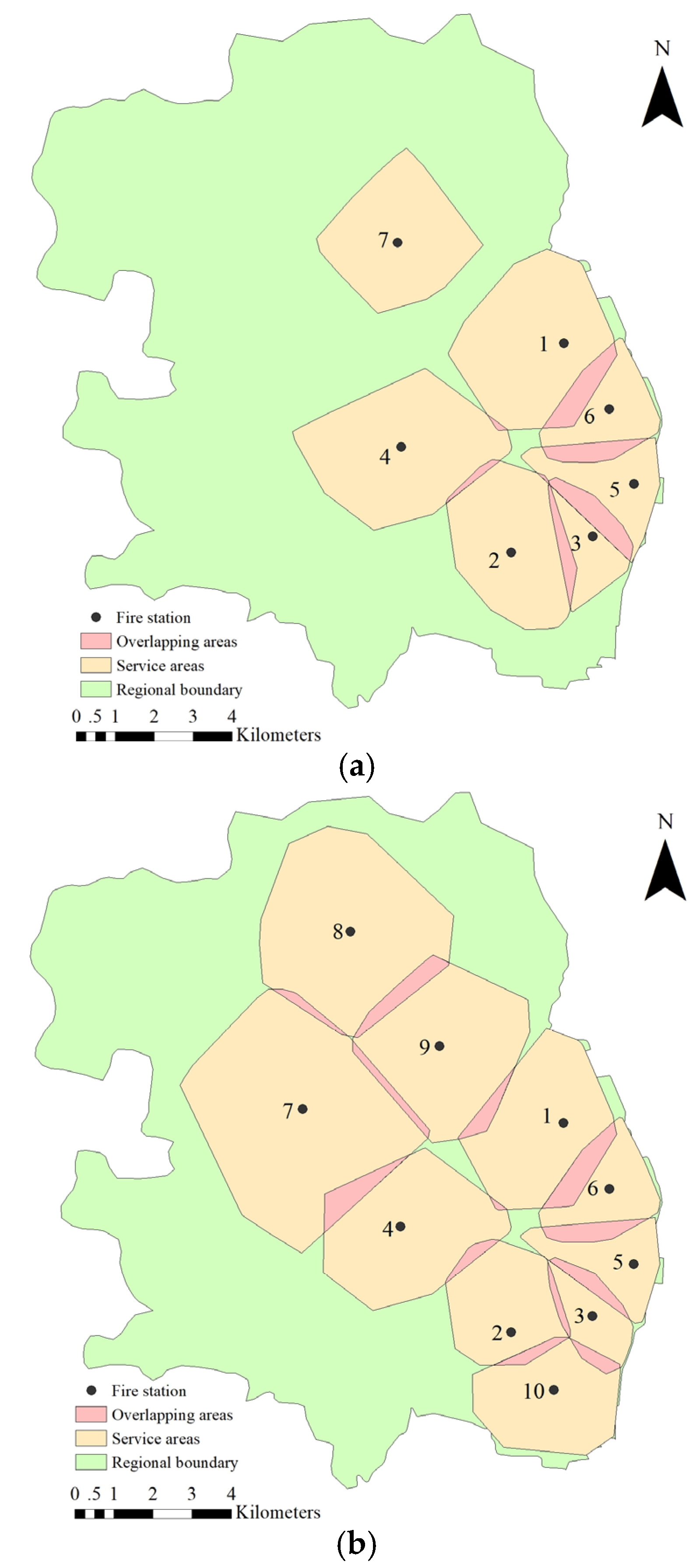
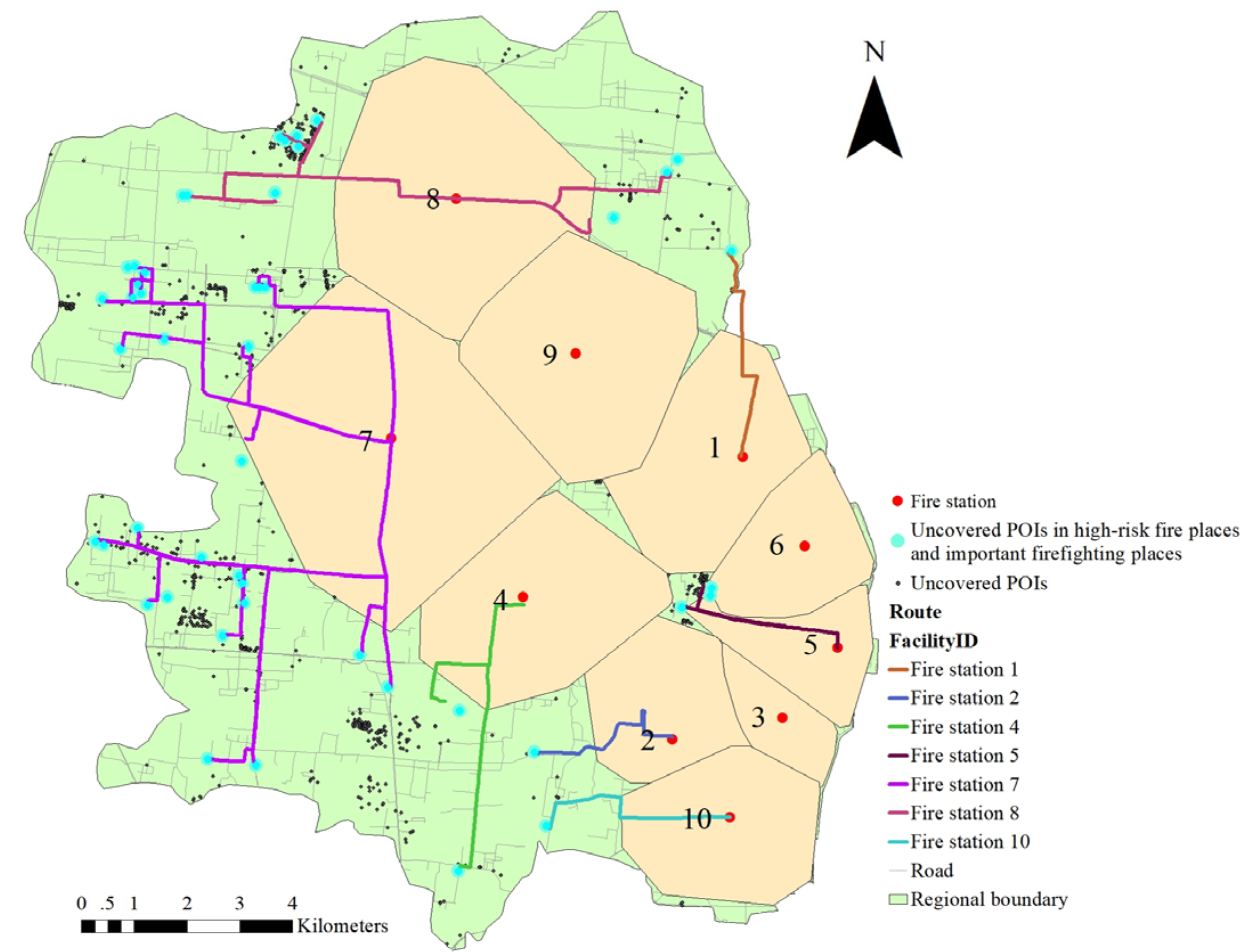
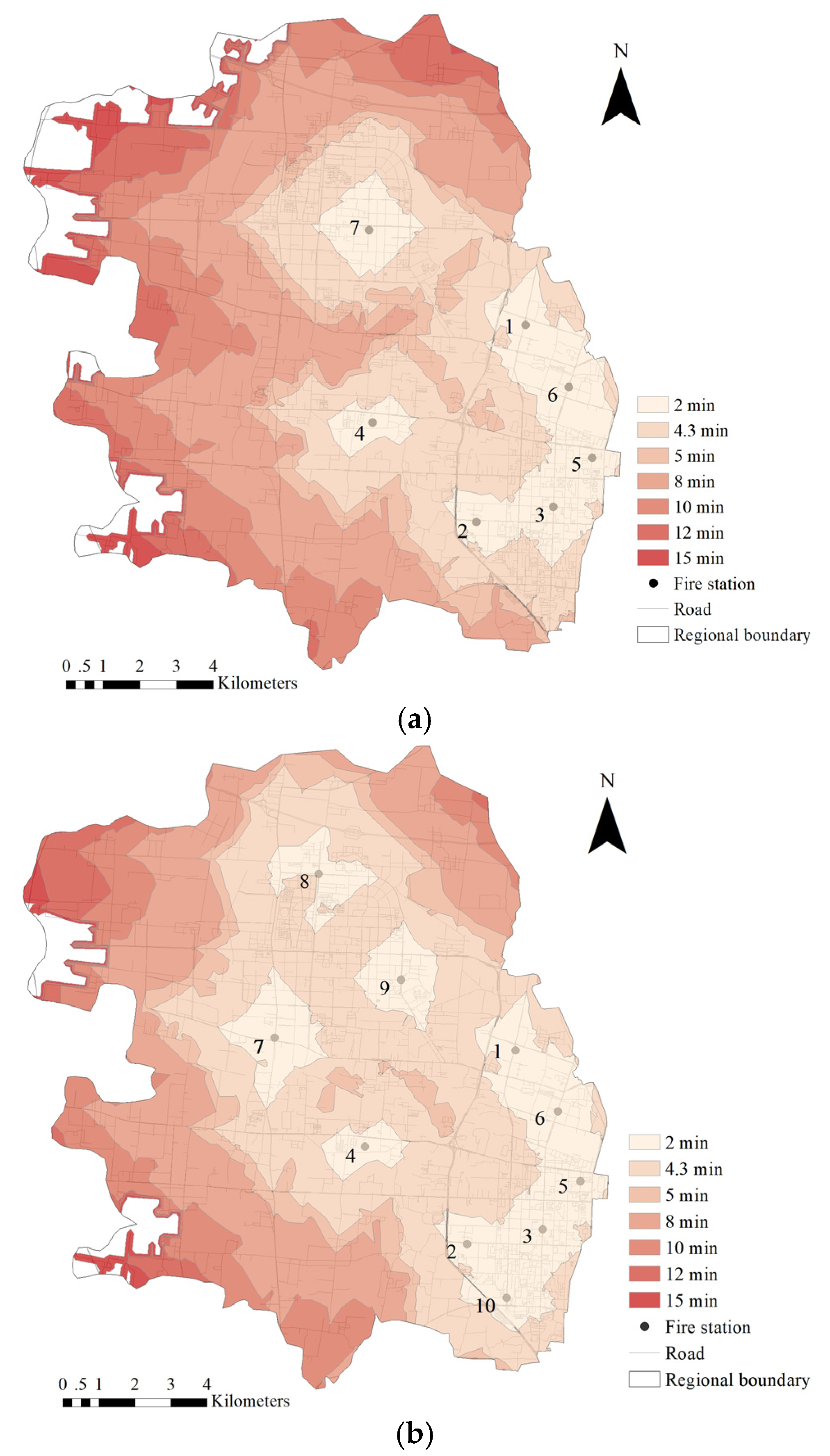
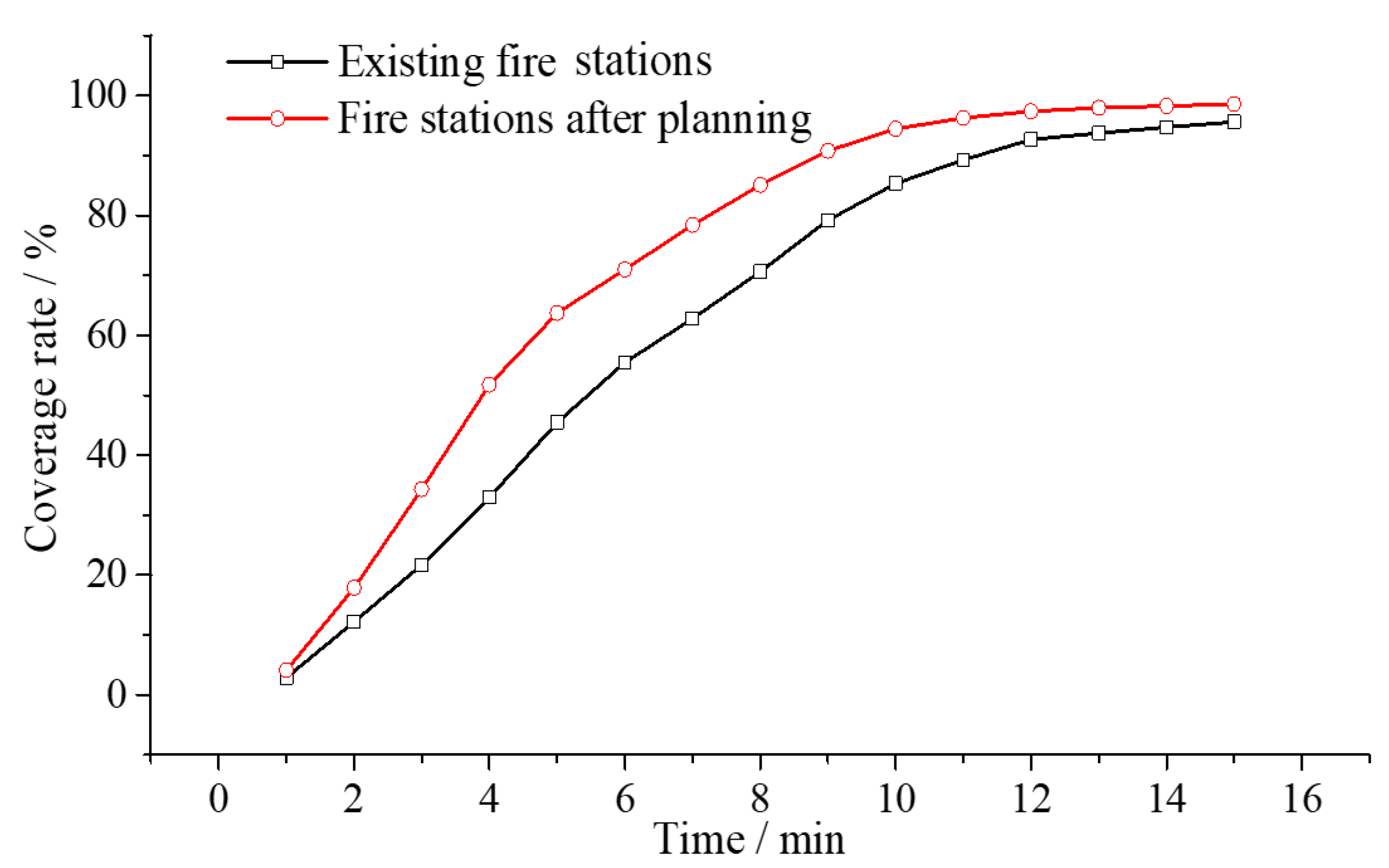
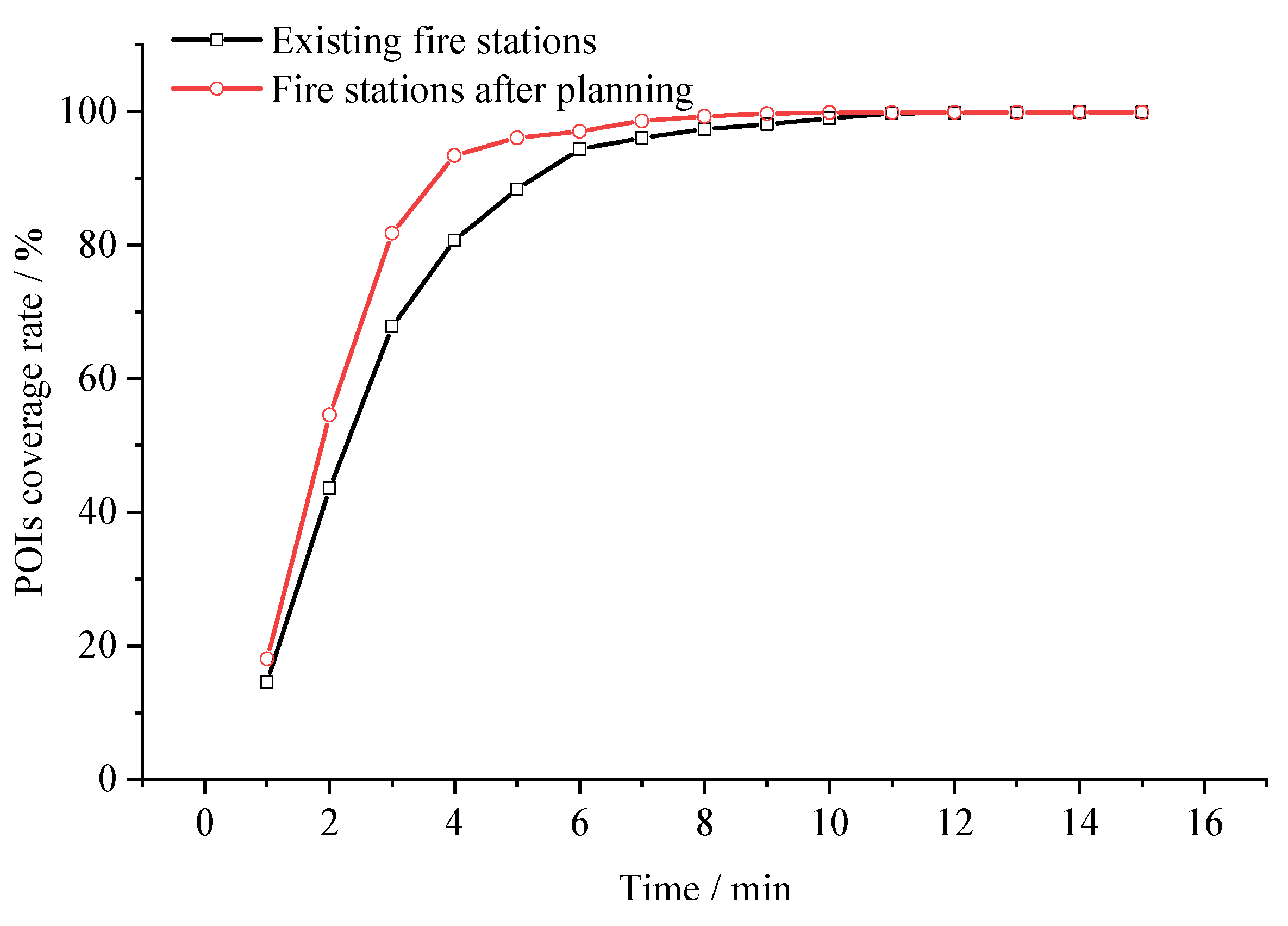
| Name | Residential Places | Hotels | Restaurants | Commerce Places | Office Places | High Fire Risk Places | Important Fire-Fighting Places | General Fire-Fighting Places |
|---|---|---|---|---|---|---|---|---|
| Number | 2238 | 536 | 4776 | 7027 | 6226 | 355 | 109 | 3853 |
| Road Grade | High-Speed Road | Main Road | Secondary Trunk Road | Branch | National Highway | Provincial Highway | Country Road |
|---|---|---|---|---|---|---|---|
| Speed/km/h | 70 | 50 | 40 | 30 | 60 | 60 | 40 |
| Total Number of Fire Stations | Number of POIs Covered | Total Time Required/min | Average Time Required/min | Number of POIs Uncovered | Coverage Rate/% |
|---|---|---|---|---|---|
| 6 | 15,072 | 26,685 | 1.77 | 10,048 | 60.00 |
| 7 | 18,072 | 32,594 | 1.80 | 7048 | 71.94 |
| 8 | 21,061 | 40,817 | 1.94 | 4059 | 83.84 |
| 9 | 22,440 | 44,207 | 1.97 | 2680 | 89.33 |
| 10 | 23,780 | 44,892 | 1.89 | 1340 | 94.67 |
| 11 | 23,867 | 40,977 | 1.72 | 1253 | 95.01 |
| 12 | 23,953 | 40,897 | 1.71 | 1167 | 95.35 |
| 13 | 23,955 | 37,540 | 1.57 | 1165 | 95.36 |
| 14 | 23,956 | 36,986 | 1.54 | 1164 | 95.37 |
| Number | Number of POIs Covered | Total Time/min | Average Time Required/min | Number | Number of POIs Covered | Total Time/min | Average Time Required/min |
|---|---|---|---|---|---|---|---|
| 1 | 2575 | 4498 | 1.75 | 6 | 2821 | 4123 | 1.46 |
| 2 | 2124 | 4865 | 2.29 | 7 | 2555 | 6756 | 2.64 |
| 3 | 3000 | 3869 | 1.29 | 8 | 2452 | 5404 | 2.20 |
| 4 | 451 | 1290 | 2.86 | 9 | 2738 | 5553 | 2.03 |
| 5 | 3000 | 5085 | 1.70 | 10 | 2064 | 3449 | 1.67 |
| 1 | 2 | 3 | 4 | 5 | 6 | 7 | 8 | 9 | 10 | ||
|---|---|---|---|---|---|---|---|---|---|---|---|
| Existing fire stations | Number of POIs covered | 2760 | 3000 | 3000 | 468 | 3000 | 2844 | 3000 | / | / | / |
| Convex hull area/km2 | 13.76 | 10.57 | 4.51 | 14.09 | 6.39 | 6.09 | 10.36 | / | / | / | |
| Fire stations after planning | Number of POIs covered | 2575 | 2124 | 3000 | 451 | 3000 | 2821 | 2555 | 2452 | 2738 | 2064 |
| Convex hull area/km2 | 12.19 | 7.85 | 3.94 | 13.19 | 5.58 | 6.09 | 25 | 18.6 | 14.18 | 8.82 |
| Total Number | Name | Residential Places | Hotels | Restaurants | Commerce Places | Office Places | High-Fire Risk Places | Important Firefighting Places | General Firefighting Places |
|---|---|---|---|---|---|---|---|---|---|
| 7 | Number | 1797 | 356 | 3434 | 5225 | 4481 | 202 | 76 | 2955 |
| Coverage rate/% | 80.3 | 66.4 | 71.9 | 74.3 | 71.9 | 56.9 | 69.7 | 76.6 | |
| 10 | Number | 2174 | 526 | 4624 | 6768 | 5720 | 317 | 100 | 3690 |
| Coverage rate/% | 97.1 | 98.1 | 96.8 | 96.3 | 91.9 | 89.3 | 91.7 | 95.8 |
| Name | Time/min | 2 | 4.3 | 5 | 8 | 10 | 12 | 15 |
|---|---|---|---|---|---|---|---|---|
| Existing fire stations | Coverage area/km2 | 23.8 | 71.7 | 88.7 | 137.7 | 166.3 | 180.7 | 186.4 |
| Coverage rate/% | 12.2 | 36.7 | 45.5 | 70.6 | 85.3 | 92.7 | 95.6 | |
| Fire stations after planning | Coverage area/km2 | 34.9 | 108.8 | 124.3 | 165.9 | 184.1 | 189.9 | 192.2 |
| Coverage rate/% | 17.9 | 55.8 | 63.7 | 85.1 | 94.4 | 97.4 | 98.6 |
Disclaimer/Publisher’s Note: The statements, opinions and data contained in all publications are solely those of the individual author(s) and contributor(s) and not of MDPI and/or the editor(s). MDPI and/or the editor(s) disclaim responsibility for any injury to people or property resulting from any ideas, methods, instructions or products referred to in the content. |
© 2023 by the authors. Licensee MDPI, Basel, Switzerland. This article is an open access article distributed under the terms and conditions of the Creative Commons Attribution (CC BY) license (https://creativecommons.org/licenses/by/4.0/).
Share and Cite
Chen, M.; Wang, K.; Yuan, Y.; Yang, C. A POIs Based Method for Location Optimization of Urban Fire Station: A Case Study in Zhengzhou City. Fire 2023, 6, 58. https://doi.org/10.3390/fire6020058
Chen M, Wang K, Yuan Y, Yang C. A POIs Based Method for Location Optimization of Urban Fire Station: A Case Study in Zhengzhou City. Fire. 2023; 6(2):58. https://doi.org/10.3390/fire6020058
Chicago/Turabian StyleChen, Mengmeng, Kai Wang, Yingfeng Yuan, and Chao Yang. 2023. "A POIs Based Method for Location Optimization of Urban Fire Station: A Case Study in Zhengzhou City" Fire 6, no. 2: 58. https://doi.org/10.3390/fire6020058
APA StyleChen, M., Wang, K., Yuan, Y., & Yang, C. (2023). A POIs Based Method for Location Optimization of Urban Fire Station: A Case Study in Zhengzhou City. Fire, 6(2), 58. https://doi.org/10.3390/fire6020058







